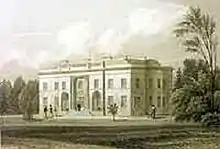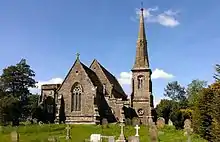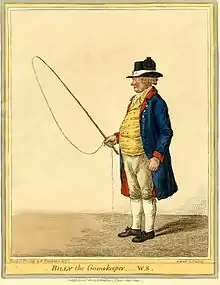Robert Frankland-Russell
Sir Robert Frankland-Russell, 7e baronnet (1784-1849) est un homme politique anglais, connu aussi comme artiste. Au début de sa vie, il s'appelle Robert Frankland.
Pour les articles homonymes, voir Frankland.
Biographie
Il est le fils de Sir Thomas Frankland (6e baronnet) et de son épouse Dorothy, fille de William Smelt. Il étudie à Christ Church, Oxford [1].
Il est élu au Parlement pour Thirsk en 1815 et démissionne de son siège en 1834. Il succède à son père comme baronnet en 1831 et, en 1836, hérite de la propriété de Sir Robert Greenhill-Russell, 1er baronnet, ajoutant à son nom de famille Russell [2]. La succession comprend Chequers, qu’il améliore, avec Edward Buckton Lamb comme architecte [3],[4]. Il est haut-shérif du Yorkshire en 1838 [5].


Après la mort de son mari, Lady Frankland-Russell charge son ami Lamb de redessiner l’église paroissiale All Saints de Thirkleby, près du siège de la famille, Thirkleby Hall, à sa mémoire [3],[6].
Le père de Frankland-Russell a étudié avec John Malchair. Il est lui-même un aquarelliste [7] et peint des scènes de chasse [8].

Famille
Il se marie en 1815 avec Louisa-Anne Murray, troisième fille de Lord George Murray. Ils ont cinq filles. À la mort du 7e baronnet, le titre est passé à son cousin Frederick William Franklin [2].
Les filles sont: [9]
- Augusta-Louisa, épouse Thomas de Grey, 5e Baron Walsingham en 1842, et mère de Thomas de Grey (6e baron Walsingham), décédée en 1844 [10]
- Caroline-Agnes
- Emily-Anne, mariée à Sir William Payne-Gallwey (2e baronnet) en 1847 [11]
- Julia-Roberta, qui épouse Ralph Neville-Grenville [12]
- Rosalind-Alicia, qui épouse Francis L'Estrange Astley en 1854 en tant que deuxième épouse. [13]
Références
- (en) Cet article est partiellement ou en totalité issu de l’article de Wikipédia en anglais intitulé « Sir Robert Frankland-Russell, 7th Baronet » (voir la liste des auteurs).
- « Frankland, Robert (1784-1849), of Thirkleby, Yorks., History of Parliament Online » (consulté le )
- Sylvanus Urban, The Gentleman's Magazine, (lire en ligne), p. 540
- « Frankland, Robert (1784-1849), of Thirkleby Park, Yorks. and 15 Cavendish Square, Mdx., History of Parliament Online » (consulté le )
- Guy McDonald, England, New Holland Publishers, , 426– p. (ISBN 978-1-86011-116-7, lire en ligne)
- William Grainge, The Vale of Mowbray: A Historical and Topographical Account of Thirsk and Its Neighbourhood, Simpkin, Marshall, and Company, (lire en ligne), p. 108
- Thomas Gill, Vallis Eboracensis: Comprising the History and Antiquities of Easingwold and Its Neighbourhood, Simpkin, Marshall & Company, (lire en ligne), p. 337
- H. L. Mallalieu, The Dictionary of British Watercolour Artists up to 1920, Antique Collectors' Club, (ISBN 978-1-85149-025-7), p. 134
- Ian Waites, Common Land in English Painting, 1700-1850, Boydell Press, (ISBN 978-1-84383-761-9, lire en ligne), p. 20
- John Burke, A General and Heraldic Dictionary of the Peerage and Baronetage of the British Empire by John Burke, Henry Colburn, , 401– p. (lire en ligne)
- Edmund Lodge, The Peerage of the British Empire, (lire en ligne), p. 576
- Edmund Lodge, The Peerage and Baronetage of the British Empire, (lire en ligne), p. 705
- The Annual Register: Or a View of the History, Politics and Literature, for the Year 1845, J. Dodsley, , 223
- The Marquis of Ruvigny and Ranieval, The Plantagenet Roll of the Blood Royal: The Mortimer-Percy Volume, Heritage Books, (ISBN 978-0-7884-1872-3), 422
Liens externes
- Ressources relatives aux beaux-arts :
- Bridgeman Art Library
- (en) Art Institute of Chicago
- (en) Art UK
- (en) British Museum
- (en + nl) RKDartists
- (en) Union List of Artist Names
- Ressource relative à la vie publique :
- (en) Hansard 1803–2005
- Portail de la politique britannique